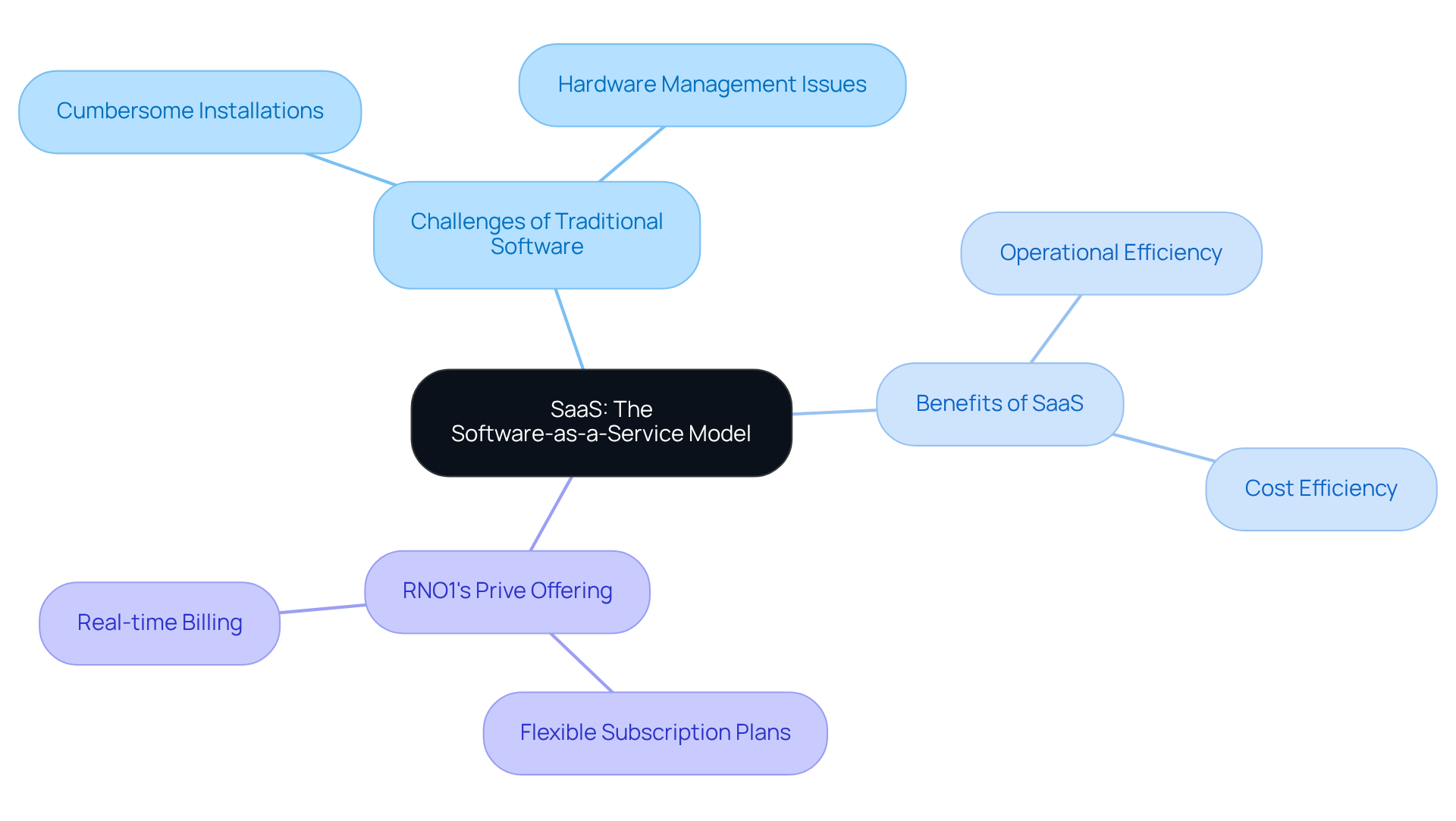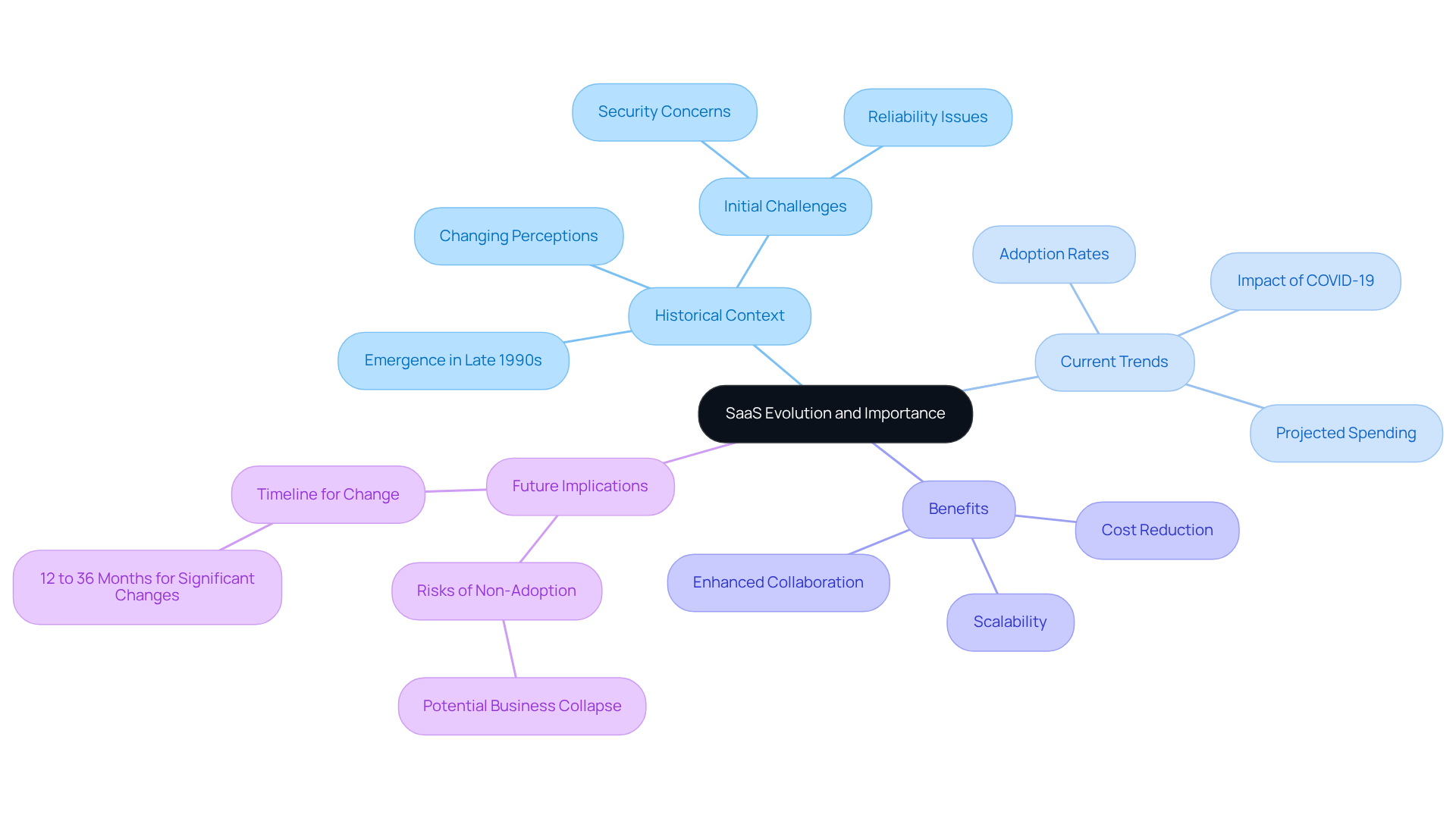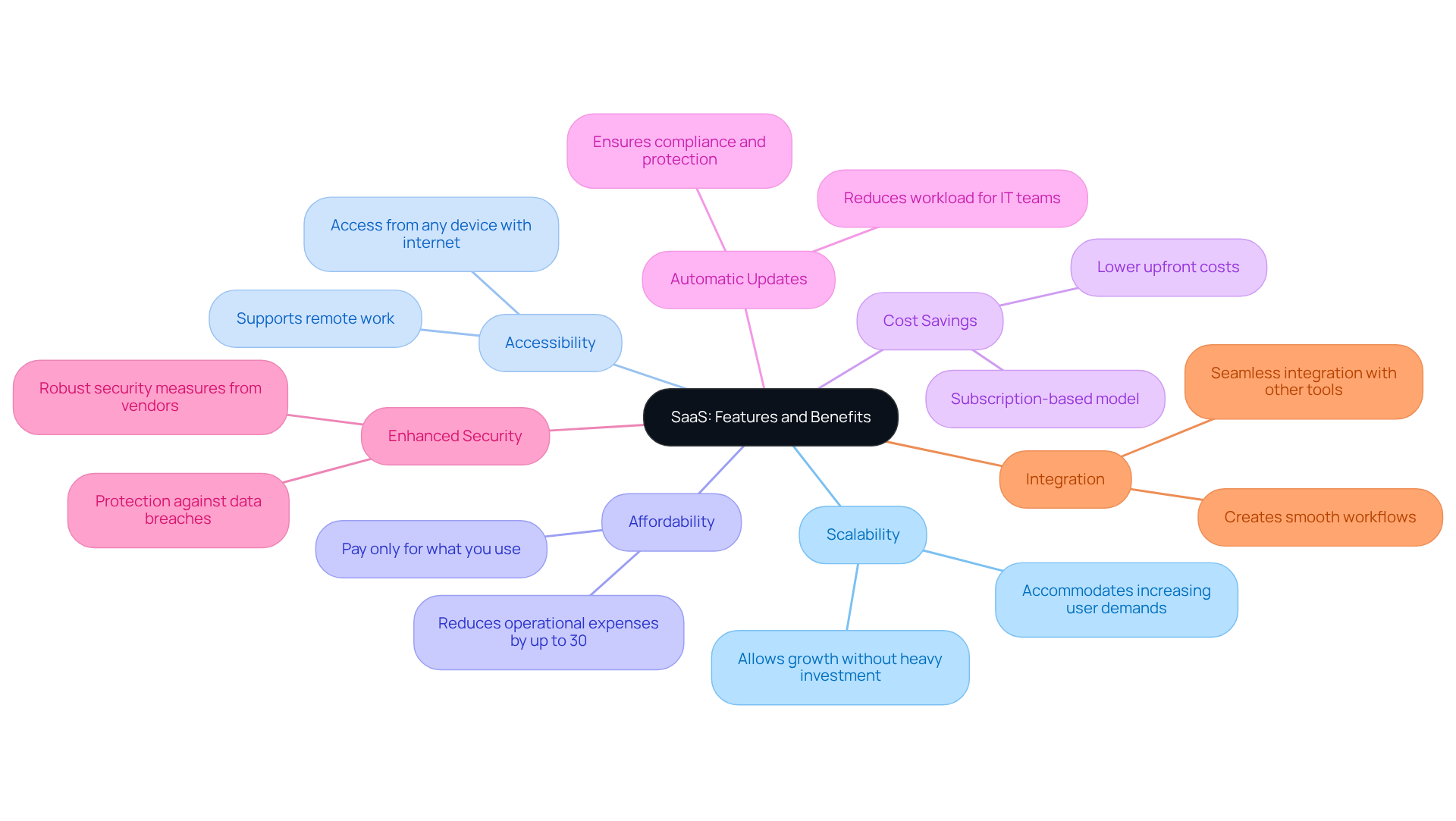Overview
In today's fast-paced digital world, many businesses struggle with operational inefficiencies and rising costs. This is a common challenge that can leave tech startup founders feeling overwhelmed and uncertain about their path forward. The implications of these issues can be significant, often leading to missed opportunities and stunted growth.
However, there is a nurturing solution available: the Software-as-a-Service (SaaS) model. SaaS offers scalable, accessible, and affordable solutions that can transform how organizations operate. By embracing this model, businesses can enhance their operational efficiency and cost-effectiveness, allowing them to thrive in an ever-evolving landscape.
Imagine a scenario where your team can easily access the tools they need, anytime and anywhere, without the burden of hefty upfront costs. This is the reality that SaaS promises, providing a lifeline for startups aiming to navigate the complexities of modern business. As you consider your options, remember that there is a supportive community ready to help you succeed. Together, we can harness the power of technology to create a brighter future for your organization.
Introduction
The rapid evolution of technology has undeniably transformed how organizations approach software management. Many are finding themselves moving away from traditional installations to the more streamlined Software-as-a-Service (SaaS) model. This shift, while promising, often brings with it a host of challenges. The burdens of hardware maintenance and software updates can feel overwhelming, leaving many to wonder how they can not only survive but truly thrive in this competitive landscape.
As businesses navigate this digital terrain, they grapple with pressing questions:
- How can they fully leverage the potential of SaaS?
- What steps can they take to enhance operational efficiency and cost-effectiveness?
It’s crucial to recognize that these concerns are valid and shared by many in the industry. The implications of not adapting can be significant, impacting everything from team morale to overall business success.
However, there is hope. By exploring the key features and business impacts of SaaS, organizations can uncover essential insights that empower them to adapt and excel in today’s modern economy. Embracing this innovative approach can lead to not just survival, but a flourishing future, filled with opportunities for growth and success. Together, we can navigate these changes and find a path forward that fosters resilience and prosperity.
Define SaaS: The Software-as-a-Service Model
In today’s fast-paced world, many organizations struggle with the complexities of managing software installations. The traditional approach often involves cumbersome physical media and local servers, leading to significant challenges in hardware management and software updates. This can create frustration and inefficiencies, making it difficult for teams to focus on what truly matters—driving their business forward.
Imagine a solution that not only eases these burdens but also enhances operational efficiency. The saas web offers just that. By hosting applications on the provider's servers, users can access them through a simple web browser. This shift eliminates the headaches of hardware upkeep and constant software updates. It’s a change that streamlines operations and improves cost efficiency, making saas web an appealing option for organizations of all sizes.
RNO1's Prive embodies this transformative model by revolutionizing subscription services for brands. With a flexible month-to-month subscription plan, RNO1 understands the dynamic needs of modern brands, offering 30-day planning and renewal options. This adaptability is crucial for businesses striving to stay ahead in a competitive landscape. Furthermore, RNO1’s real-time billing capability empowers businesses to act swiftly, allowing them to focus on outcomes while being charged in real-time as they develop new strategies. This innovative approach not only helps brands to respond quickly to market changes but also fosters growth and operational resilience.
We invite you to explore how RNO1 can support your journey, providing the tools and flexibility you need to thrive in today’s ever-evolving environment. Together, we can navigate these challenges and unlock new opportunities for success.

Contextualize SaaS: Evolution and Importance in Modern Business
The emergence of the Software as a Service (SaaS) model in the late 1990s and early 2000s brought about significant change, yet it was not without its challenges. Many organizations initially approached SaaS with skepticism, grappling with concerns over security and reliability. This hesitation is understandable, as businesses sought assurance in their software solutions. However, as cloud computing evolved and matured, these concerns began to fade, paving the way for widespread adoption. Today, the SaaS web is not just a trend; it is a cornerstone of digital transformation, enabling organizations to reduce costs, enhance collaboration, and achieve greater scalability.
The COVID-19 pandemic has only intensified this shift, as remote work has created an urgent need for dependable and accessible technological solutions. In fact, by 2025, software applications delivered as a service are projected to account for a substantial portion of corporate software spending. This shift underscores the critical role that SaaS plays in modern organizational strategies. Moreover, it is alarming to note that 40% of enterprises may face collapse in the next decade if they fail to embrace new technologies. This statistic highlights the pressing need for businesses to adopt innovative solutions.
Tech leaders, including Jeff Bezos, remind us that "there is no substitute for digital transformation." This statement resonates deeply, as it emphasizes the strategic importance of software solutions for companies striving to thrive in an increasingly digital environment. As organizations navigate the complexities of digital transformation, it is essential to recognize that significant changes can occur within 12 to 36 months of implementing these software solutions. This timeline reinforces the importance of adaptability and creativity in this transformative journey.
In this evolving landscape, we invite you to reflect on your own experiences and consider how embracing SaaS web can support your organization's growth and resilience. Together, we can navigate these challenges and foster a community that thrives on innovation and collaboration.

Identify Key Characteristics of SaaS: Features and Benefits
In the fast-paced world of technology, many startup founders grapple with the challenge of limited resources. This can lead to feelings of overwhelm as they strive to establish their businesses while managing operational costs. Fortunately, SaaS web applications designed with scalability, accessibility, and affordability in mind can serve as a lifeline for both startups and established enterprises alike.
Imagine being able to scale your operations effortlessly, accommodating increasing user demands without the burden of hefty infrastructure investments. With these applications, you can access your tools from any device with an internet connection, making remote work not just a possibility, but a seamless reality. This flexibility is crucial for fostering a productive work environment, especially in today’s landscape where remote collaboration is more important than ever.
Moreover, the SaaS web subscription-based model significantly alleviates the financial strain on startups. By allowing companies to pay only for what they use, this model is particularly beneficial for those managing tight budgets. Statistics show that businesses leveraging SaaS can achieve substantial cost savings—firms frequently report operational expenses reduced by up to 30%. As the global SaaS web market is projected to grow from $315.7 billion in 2025 to $1.13 trillion by 2032, it’s clear that the reliance on cloud-based services is becoming a cornerstone of modern business.
Additionally, the peace of mind that comes with automatic updates and enhanced security measures offered by vendors is invaluable. This ensures compliance and protection without adding to your workload. The ability to integrate seamlessly with other software tools further enhances operational efficiency, creating smooth workflows across various platforms.
As industry specialists highlight, 'Due to the ongoing rise in remote work, strong and effective software solutions are necessary for communication and collaboration.' The scalability and accessibility of SaaS web are not just features; they are essential for organizations aiming to innovate and adapt in a rapidly changing market. By embracing these solutions, you can facilitate growth and position your startup for success in 2025 and beyond.
In this journey, remember that you are not alone. The right software solutions can empower you to navigate challenges with confidence, allowing you to focus on what truly matters—growing your vision and making a meaningful impact.

Conclusion
The SaaS model has emerged as a transformative force in the business landscape, reshaping how organizations manage their software needs. Many businesses face the challenges of traditional software installations, dealing with hardware maintenance and frequent updates that can feel overwhelming. By shifting to a cloud-based approach, companies can eliminate these burdens, enhancing operational efficiency and allowing them to focus on their core objectives. This shift is not just about efficiency; it’s about driving growth and innovation in a nurturing environment.
As we reflect on the journey of SaaS, it’s clear that what began with skepticism has evolved into a cornerstone of digital transformation. The flexibility and scalability offered by SaaS applications cater to diverse needs, whether for startups finding their footing or established enterprises seeking to innovate. The subscription-based model significantly reduces operational costs, enabling companies to pay only for what they use. In a world where remote work is becoming the norm, the importance of effective software solutions for collaboration and communication is more crucial than ever.
Navigating the complexities of the digital age can feel daunting, but embracing SaaS solutions is essential for survival and growth. The projected growth of the SaaS market underscores its critical role in shaping the future of business operations. By adopting these innovative technologies, companies can position themselves to thrive in an increasingly competitive landscape, fostering a culture of resilience and adaptability.
Now is the time to act—exploring SaaS options can unlock new opportunities and drive meaningful change in your organization. Together, let’s embrace the future with compassion and confidence.
Frequently Asked Questions
What is SaaS?
SaaS, or Software-as-a-Service, is a model where applications are hosted on a provider's servers and accessed by users through a web browser, eliminating the need for physical media and local servers.
What are the advantages of using SaaS?
The advantages of SaaS include improved operational efficiency, reduced hardware management, simplified software updates, and enhanced cost efficiency for organizations.
How does RNO1's Prive exemplify the SaaS model?
RNO1's Prive exemplifies the SaaS model by offering a flexible month-to-month subscription plan, real-time billing capabilities, and 30-day planning and renewal options that cater to the dynamic needs of modern brands.
Why is flexibility important for businesses using SaaS?
Flexibility is important because it allows businesses to adapt quickly to market changes, respond to evolving demands, and maintain operational resilience in a competitive landscape.
How does RNO1 support businesses in their SaaS journey?
RNO1 supports businesses by providing tools and flexibility necessary for growth, enabling them to focus on outcomes while navigating challenges and unlocking new opportunities for success.




